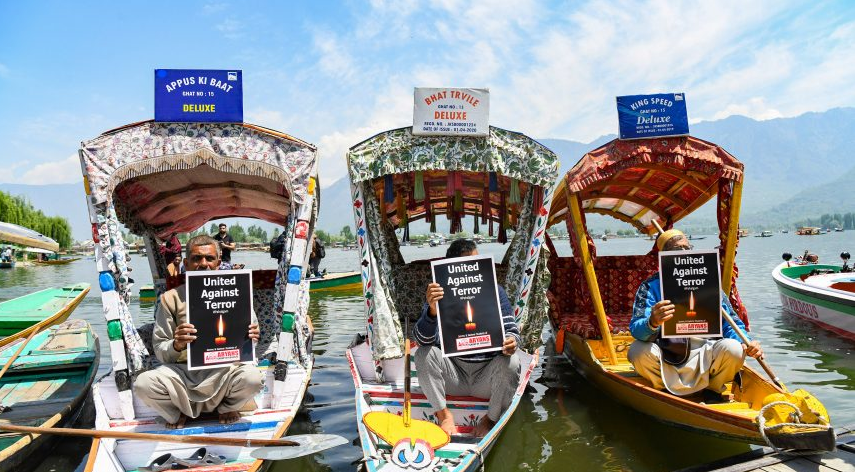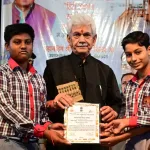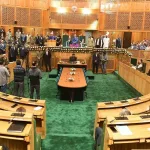REVIVE TOURISM SECTOR
The soul of Kashmir has long resonated through the melodic ripple of its rivers, the whispering pines of its meadows, and the welcoming warmth of its people. Yet, the tragic events of the Pahalgam massacre have cast a long and melancholic shadow over this resplendent valley. As blood was spilled where laughter once echoed, a palpable sense of fear took root—not only in the hearts of locals but in the collective imagination of potential visitors. The immediate aftermath has witnessed a sharp dip in tourist inflow, striking a severe blow to an already fragile economic structure heavily reliant on tourism.
This decline is more than just a seasonal slump. It is an emotional and psychological retreat, as images of violence replace those of shikaras gliding over the still waters of Dal Lake. Hotels that once brimmed with life now echo with emptiness. Artisans who lived off the charm of their craft find their looms idle. Taxi drivers, houseboat owners, ponywallahs, and guides—who make their living from the seasonal heartbeat of tourism—now face deepening uncertainty. The question, then, is not just how to revive the numbers but how to restore faith, security, and dignity in a place that has always prided itself as paradise on earth.
To address this slump effectively, a multi-pronged strategy—emotionally intelligent, administratively sharp, and imaginatively bold—is required. First and foremost, security assurance must be paramount. The government must swiftly communicate its commitment to safety through visible and well-planned action. Confidence-building measures, including the swift identification and neutralization of threats, and increased coordination between local police, intelligence agencies, and central forces, are not just matters of defence—they are investments in trust.
Second, the narrative around Kashmir must be reclaimed. In an era dominated by visuals and perception, curated media campaigns—grounded in authenticity rather than cosmetic gloss—are vital. Short documentaries, real-time travelogues, and testimonials from recent visitors can help challenge the image of a valley in turmoil. Influencers, travel journalists, and even diaspora Kashmiri voices must be involved in a deliberate campaign that brings out the resilience, hospitality, and raw beauty of the region. Let the world see the untold stories of villagers helping stranded tourists, of communities uniting against terror, and of a land that refuses to be defined by its wounds.
Third, institutional and grassroots partnerships are essential. Travel agencies and tour operators need reassurance through incentives. Insurance-backed packages, risk mitigation training, and emergency protocols can help bridge the trust deficit. Furthermore, collaborations with states that traditionally send the highest number of tourists—like Maharashtra, Gujarat, and Tamil Nadu—can be deepened through special roadshows, promotional fares, and inter-state cultural exchanges.
Fourth, infrastructure must be fine-tuned not just for volume but for resilience. Creating all-weather roads to major destinations like Gulmarg, Sonamarg, and Pahalgam, setting up smart surveillance systems in tourist hubs, and maintaining emergency medical and evacuation systems will enhance not just the comfort but the confidence of visitors. In addition, establishing regional tourist security cells with multilingual support, panic buttons in cabs and hotels, and an AI-enabled tourism grievance redressal app can modernize the perception of Kashmir as a safe, smart destination.
Equally crucial is the emotional healing of the local population. A wounded host cannot extend wholehearted hospitality. The government and civil society must invest in trauma care, community healing initiatives, and local entrepreneurship revival. When the people of Kashmir feel protected, heard, and economically stable, their natural warmth and legendary hospitality will again become the valley’s strongest advertisement.
Special tourism festivals, post-crisis revival carnivals, and free-of-cost or discounted stays for a select number of first-time visitors can serve as morale boosters and image restorers. The symbolic value of even a few hundred tourists returning safely and happily cannot be overstated. It becomes the turning of a page, a punctuation in a long sentence of sorrow.
Furthermore, spiritual and heritage tourism—which draws visitors not for leisure but for deeper connection—must be promoted. The sacred sites of Kashmir, including the Amarnath Shrine, Hazratbal, Kheer Bhawani, and Zyeshtha Devi, can anchor faith-driven tourism. Promoting these spiritual circuits, along with Buddhist and Sufi heritage trails, could attract a more resilient and purposeful demographic less likely to be dissuaded by momentary instability.
Ultimately, it is the local voices that must lead the chorus of revival. Empowering panchayats, municipalities, and mohalla committees with tourism-related funds and decision-making powers will democratize recovery. The narrative must shift from “Kashmir needs tourists” to “Kashmir welcomes you once more—with strength, spirit, and safety.”
Yes, the wounds of Pahalgam are fresh. The silence in the valley is still punctuated by sighs. But Kashmir has seen many winters and has always found spring again. The saffron fields will bloom, the chinar leaves will turn gold, and the people will once again ready their homes and hearts for guests.
Let us remember: paradise may stumble, but it never falls. With careful steps, collaborative will, and honest storytelling, Kashmir can—and will—rise again as the crown of India’s tourism tapestry.
(Author is RK columnist and can be at: [email protected]; @ Sanjay.Pandita)








